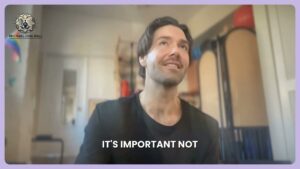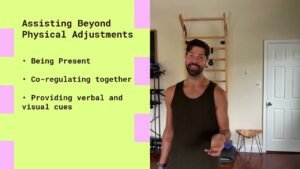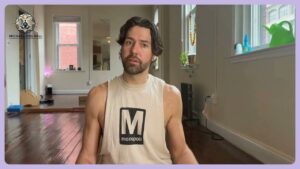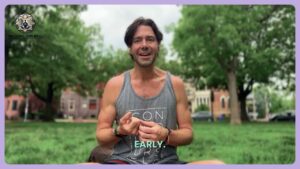Video: Ashtanga Vinyasa Inspired Flow
75 Minutes
6:12:12:6 grower pranayama
Touch & Go Standing
Intermediate A
Advanced A
Primary Marichi
Maitri Meditation
75 Minutes
6:12:12:6 grower pranayama
Touch & Go Standing
Intermediate A
Advanced A
Primary Marichi
Maitri Meditation

In this video, yoga instructor Michael Joel Hall discusses the profound interconnectedness experienced through yoga practice. He shares insights from his 15 years of teaching, highlighting how individual efforts on the mat create a collective energy that enhances the practice for everyone. Michael explains how synchronization of breath and movement among practitioners creates a palpable atmosphere of presence. He delves into the ripple effect of individual breakthroughs and how they uplift the entire room. The video also covers practical approaches to harnessing this interconnectedness, such as collective breathing, shared energy, and mindful transitions. Ultimately, Michael emphasizes that yoga is about recognizing and nurturing the deeper connections that unite us all, transcending time, space, and individual experiences.
00:00 Introduction: The Power of Interconnectedness in Yoga
00:36 The Ripple Effect of Practice
01:26 Beyond Time and Space: Infinite Interconnectedness
02:17 Practical Applications of Interconnectedness
02:55 The Bigger Picture: Interconnectedness in Life and Yoga
03:41 Conclusion: Embracing the Infinite Connection

In this video, Michael Joel Hall discusses the ongoing debate within the Ashtanga yoga community about incorporating complementary exercises, such as swimming, running, and strength training, into their routines. He addresses how these activities can enhance cardiovascular endurance, joint stability, and overall strength without detracting from the primary yoga practice. Michael emphasizes the importance of integrating these exercises mindfully to prevent repetitive strain injuries and maintain a sustainable yoga practice over a lifetime.
00:00 Introduction to Ashtanga Yoga
00:10 The Need for Cross Training
00:30 Benefits of Cross Training
01:04 Integration and Balance
01:18 Conclusion: Sustaining a Lifelong Practice

The Art of Assisting in Ashtanga Yoga: Beyond Physical Adjustments
In this video, Michael Joel Hall, a seasoned Ashtanga Yoga teacher based in Washington DC, delves into the nuanced art and responsibility of assisting in yoga practice. Hall emphasizes that assisting is not about fixing students but about supporting their personal practice through presence and understanding. Drawing on systems thinking and yoga philosophy, he discusses the significance of verbal, visual, and physical assists, the importance of consent and trauma awareness, and the spiritual dimension of assisting within the framework of the eight limbs of yoga. The key message is to support the students’ exploration and self-organization rather than imposing corrections, advocating for a holistic approach that respects individual needs and fosters mutual growth.
00:00 Introduction and Welcome
00:08 The Art and Responsibility of Assisting
01:04 Purpose of Assisting in Ashtanga Yoga
01:48 Supporting an Intelligent System
03:21 Spiritual Practice of Assisting
05:50 Types of Assists: Verbal, Visual, Physical
08:17 Consent, Touch, and Trauma Awareness
10:27 Feedback Loops in Assisting
12:36 Adaptation and Individualization

In this video, Michael Joel Hall discusses the importance of integrating all eight limbs of Ashtanga yoga, rather than focusing solely on the physical practice of asanas. He addresses the potential pitfalls of modern practices, such as the risk of turning yoga into just another workout, the impact of social media on the practice, and the ethical dilemmas faced in a performance-driven culture. Hall advocates for a more comprehensive approach that includes elements like meditation, ethical study, and understanding of foundational texts to truly cultivate a holistic yoga practice.
00:00 Introduction to Modern Ashtanga Yoga
00:08 Criticism and Holistic Approach
00:44 Ethical Dilemmas in Social Media
01:18 Integrating All Eight Limbs
01:31 Conclusion

Title: Embracing Progress: Adding More Poses and Exploring New Series in Ashtanga Yoga
—
**Introduction to Ashtanga Yoga**
Hello, I’ve been reflecting on the Ashtanga Asana practice, specifically about integrating more poses and exploring new series. Advancing in Ashtanga yoga isn’t about simply adding new postures. Perhaps you’ve heard this before, but it’s important to emphasize its truth.
**Understanding the Purpose of New Postures**
Ashtanga yoga is fundamentally a system for personal insight and growth. The progression to new postures allows us to deepen our understanding and application of previous learnings. This journey from one series to the next, for instance, from the primary to the intermediate series, is built upon developing depth in practice.
The primary series serves as therapy for the physical body, while the intermediate series, as Rolf highlights, focuses on cleansing the nervous system. Introducing poses from the next series requires knowing the purpose they serve and breaking them down into manageable pieces. This understanding ensures these stimulating postures enhance your practice without disrupting your life.
**Balancing Primary and Intermediate Series**
Maintaining balance as you transition from primary to intermediate series is crucial. You must ground yourself in the primary series, observing your breath and nervous system, before taking on new challenges. Progression should offer a challenge, not overwhelming pressure.
Deciding when to progress is equally critical. Some teachers may suggest a gradual introduction, like combining half of the primary with half of the intermediate series. Such strategies provide a mix of benefits beyond rigid sequential orders, catering to students ready to deepen their practice.
Feeling integrated and effortless in your primary postures can signal readiness for the next series. Steady breath through back-bending and effective energy management will also be necessary for what follows.
**Transitioning Between Series**
Recovery and readiness are essential before embracing a new series. Chronic depletion suggests you’re not ready for something new. Understanding the shift from primary’s external rotation focus to intermediate’s internal rotation and spine extension is key.
Premature advancement can lead to overstimulation and agitation instead of nourishment and transformation. Success in Ashtanga isn’t about perfecting postures, but evolving understanding through practice. Advancement means readiness to embrace each series with the honor it deserves.
The best transitions are those that respect your past learnings and future aspirations without rushing past present lessons. Embrace the practice at your pace, whether you’re in the midst of transitioning or building foundational strength.
Remember, Ashtanga is as much about the journey as it is about the destination. Enjoy and respect each stage of your practice as it unfolds.

In this video, Michael Joel Hall delves into the concept that obstacles are not roadblocks but integral parts of our spiritual journey. Drawing from personal experiences and teaching observations, he explores how challenges serve as profound teachers, revealing our limiting beliefs and building spiritual strength. Hall explains the different types of obstacles, both external and internal, and emphasizes the importance of perspective in transforming these challenges into opportunities for growth. He highlights how obstacles can guide us toward our dharma and deepen our understanding.
00:00 Introduction: Embracing Obstacles for Spiritual Growth
00:24 Understanding the Nature of Obstacles
01:04 The Spiritual Purpose of Challenges
01:37 Approaching Obstacles as a Spiritual Practice